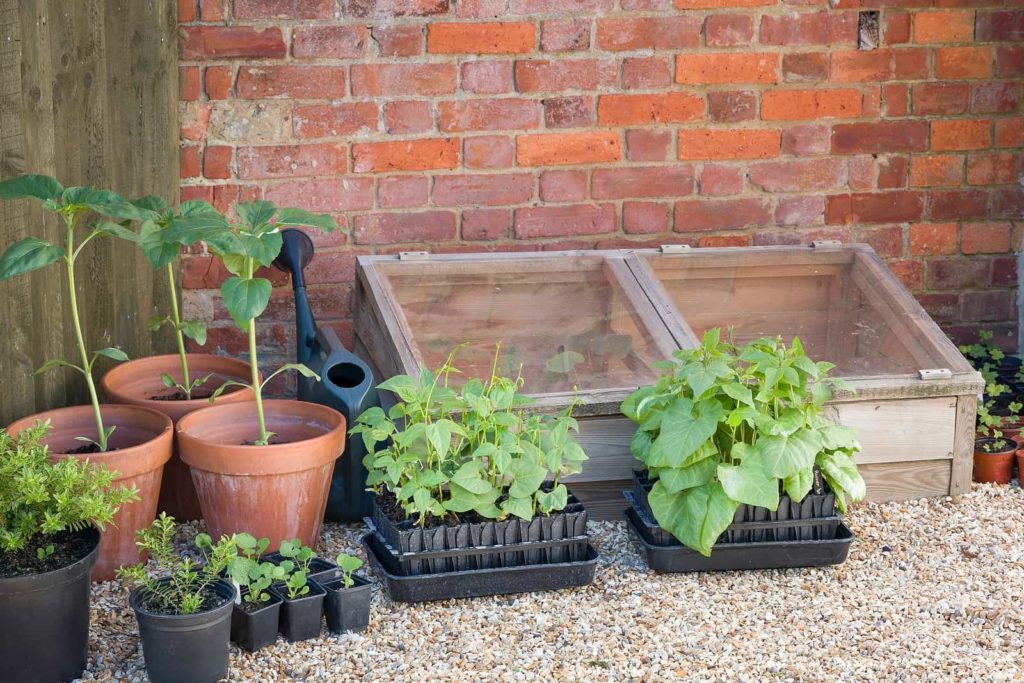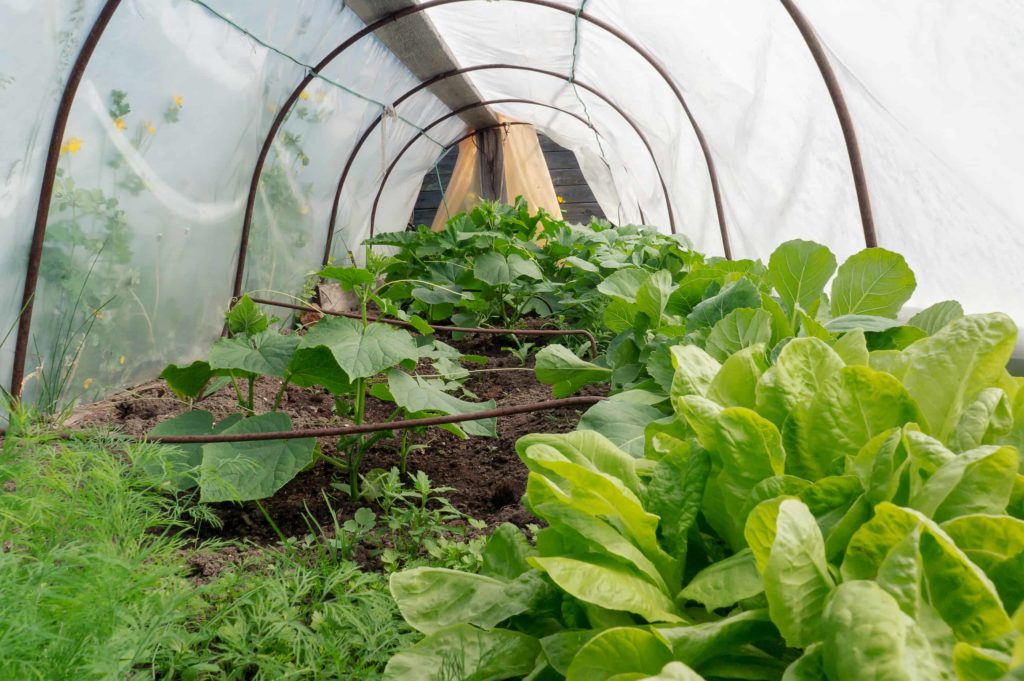There are proven ways to extend the growing season. Season extension is the garden term for growing crops outside of the natural growing time Mother Nature gives each year.
Days and nights with frost or freezing temperatures are not part of the natural growing season. But very cold weather does not mean you can’t keep growing. Protecting vegetables and herbs with season-extending devices can keep the garden productive.
When freezing temperatures are expected, most vegetable garden crops will benefit from protection. Use cloches, row covers, plastic tunnels, and cold frames to protect your crops from frost or a freeze and extend the growing season, either in spring or autumn.

Keeping crops warm
The simplest crop protection–a light blanket or overturned cardboard box–will protect plants by 1° or 2°F. A plastic or glass cloche, plastic tunnel, or simple cold frame can provide 3° or 4°F or more–often as much as 7°F–in additional temperature protection.
Adding temperature protection for your vegetables can be the equivalent of transporting them to another growing zone. Vegetables growing in a Maine winter may feel as though they are living in Georgia with the right temperature protection. That is three or four growing zones difference. Crop protection can be the equivalent of giving your crops more time–even several months of the growing season.
Preparing vegetables for frost and freezing weather
Here are things to do in the garden when a frost or freeze is forecast:
• Water crops thoroughly before a freeze: wet soil freezes more slowly than dry soil.
• When you cover crops, avoid allowing the covering to touch the crop; set up a frame to keep blankets, horticultural cloth, or other covers from actually touching leaves.
• Remove covers or ventilate when warm weather returns. Temperatures will rise under cover with the return of warm weather.
• Don’t assume that all vegetables will die in freezing weather–warm-weather crops likely will die if not protected–but many vegetables can recover from a freeze (Brussels sprouts, cabbage, garlic, kale, some lettuce, mâche, parsley, and spinach to name several).
• Visit the garden in cold weather just as you do in warm weather to keep your hands on the pulse of the garden.
Vegetable garden season extenders

Cold frame
A cold frame is an open-bottomed box that is placed over crops to act like a small greenhouse. Cold frames are heated by the sun. (A hotbed is similar to a cold frame but is usually heated by electric cables placed under the growing bed.) A cold frame is a low-profile structure with a slanting, transparent roof and no bottom that is easily moved; its box-like sides are sunk into the ground to make the structure airtight. Cold frames are easily constructed: the sides can be made out of decay-resistant wood or concrete blocks and should be tall enough to clear the tallest plant you grow. The top or roof can be made out of glass, fiberglass, Plexiglas, or heavy clear plastic sheeting. The translucent top is usually hinged to the frame and fits snuggly to create a greenhouse effect. Cold frames can provide 7°F or more in temperature protection. A cold frame covered with tarps, blankets, mats, straw or a mix of manure and straw can many crops through the coldest winter.

Plastic tunnels and covers
Plastic tunnels work much like cold frames to protect plants from cold and poor weather. A plastic tunnel can be made from clear plastic sheeting (2 mils thick or greater) stretched over half hoops made out of 10-gauge wire or ½-inch PVC bendable pipe. Cut pieces long enough to arch 14 to 18 inches above your beds or rows. The edges of the sheeting should be secured to the ground or buried. Plastic tunnels and covers will provide temperatures 2 to 7ºF warmer than the outside temperature, protecting plants from the nighttime cold. Cut vents in the plastic to allow heat to escape. Tunnels should not be used when temperatures consistently reach greater than 60º to 70º F.

Cloches
A cloche is a small glass or plastic or another type of container or cover about the size of a gallon jug that can be placed over the top of a plant to form a mini-greenhouse. A cloche should be set deep enough that it remains anchored when windy. The cap or the cloche should be removed when the outside temperature rises to 50º to 60ºF degrees to prevent excessive heat buildup. Cloches provide warmth and wind protection as well as protection from heavy rain or hail.

Row covers
Row covers are made of permeable fabric-like material such as spun-bonded polyester or polypropylene–often called horticultural cloth–which allows light, air, and water to penetrate. Heat does not build up under lightweight covers so plants can remain covered all summer. Heavy row covers should be removed when temperatures rise above 86ºF or plants can become too hot. Covers should be removed when the flowers of insect-pollinated vegetables appear. Be aware that row covers don’t have the greenhouse properties of other season extenders. They warm rows 2° to 3°F compared to the surrounding air which is usually just enough to save a crop from a late or early frost.
Hot kaps or paper hats
Hotkaps, hot kaps, or plant hats made out of folded newspaper will protect plants from a light frost by keeping the soil and air temperature around plants higher. Hot kaps are a quick way to protect small plants and seedlings.
More tips to extend the growing season:
Cold Frame to Extend the Season
Plastic Tunnels for Growing Vegetables















